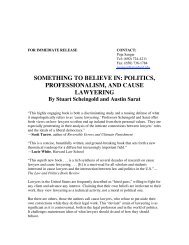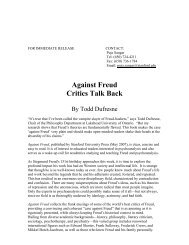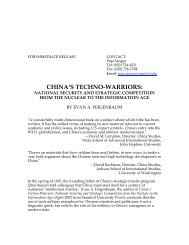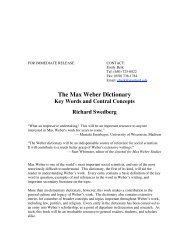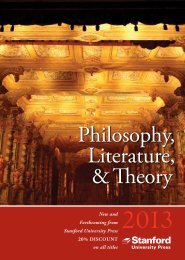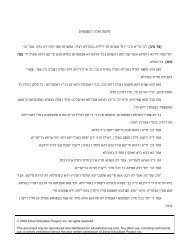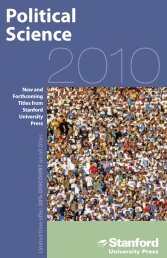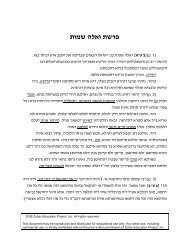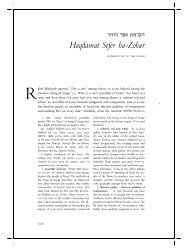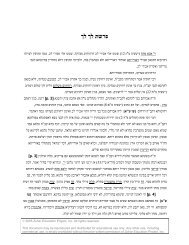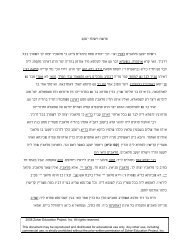Front Matter (PDF) - Stanford University Press
Front Matter (PDF) - Stanford University Press
Front Matter (PDF) - Stanford University Press
You also want an ePaper? Increase the reach of your titles
YUMPU automatically turns print PDFs into web optimized ePapers that Google loves.
egarding the Zohar that have been written since Scholem began the<br />
insights<br />
of modern Kabbalah scholarship. While responsibility for any misunder-<br />
era<br />
or omissions in this introduction are entirely my own, I wish to<br />
standings<br />
fully that the insights contained within it are those of three or<br />
acknowledge<br />
generations of scholars who have labored hard as today's meḥatstsedei<br />
four<br />
``reapers in the ®eld,'' of Zohar scholarship. Many of these are members<br />
ḥaqla,<br />
the Academic Committee for the Translation of the Zohar, andtheirnames<br />
of<br />
listed on page XX. I am grateful to each of them for their contributions to<br />
are<br />
collective efforts to understand even ``a drop in the sea'' of the Zohar's profound<br />
our<br />
secrets.<br />
mysticism in the Middle Ages is a rereading of earlier Jewish tradition,<br />
Jewish<br />
the Bible and the corpus of rabbinic literature. It has to be<br />
includingboth<br />
in the context of the great project of medieval Jewry as a whole,<br />
understood<br />
interpretation of a received, authoritative, and essentially complete body of<br />
the<br />
Jewish teaching. This body of teaching, canonized in the Gaonic age<br />
normative<br />
centuries), nominally commanded the loyalty of all Jewry, with<br />
(eighth±tenth<br />
exception of a Karaite minority. But the deeper attachment of Jews to this<br />
the<br />
had to be re-won constantly, especially in the face of both Christian<br />
tradition<br />
Muslim polemics against Judaism, ever the religious culture of a minority<br />
and<br />
in the shadow of one or the other of its giant offspring. Increasingly,<br />
living<br />
new intellectual currents that came into fashion amongthe Jews also<br />
various<br />
a need for defense or reinterpretation of the tradition. These<br />
occasioned<br />
Mut'azilite Philosophy, Neoplatonism, and Aristotelianism. The classic<br />
included<br />
form for such reinterpretation of authoritative texts was the commentary,<br />
on one or more books of the Bible or on a part of the Talmudic<br />
whether<br />
Kabbalah, a new sort of mystical-esoteric exegesis ®rst appearing in the<br />
legacy.<br />
century, may be seen as another medieval rereadingof the received<br />
twelfth<br />
canon.<br />
Jewish<br />
order to understand the ways in which Kabbalah, and particularly the<br />
In<br />
®nds its home within the earlier tradition, we need to distinguish ®ve<br />
Zohar,<br />
that are present in the legacy that medieval Jews had received from<br />
elements<br />
Judaism of late antiquity or the Talmudic age. Although these ®ve are not at<br />
the<br />
equal either in the amount of text devoted to them or in the degree of<br />
all<br />
authority with which they are accredited, each was to play an impor-<br />
formal<br />
role in the new con®guration of Judaism that Kabbalah represents.<br />
tant<br />
of the ®ve is aggadah, the narrative tradition, contained in the Talmud<br />
First<br />
the various works of Midrash. Midrash is a hermeneutical term, renderable<br />
and<br />
as ``inquiry'' and ``homiletics,'' indicatinga way of delvinginto Scripture<br />
both<br />
tended toward fanciful and extended rereadings. Much of aggadah is<br />
that<br />
in content, expandingbiblical history and recreatingthe biblical<br />
legendary<br />
Introduction<br />
II<br />
xxx



